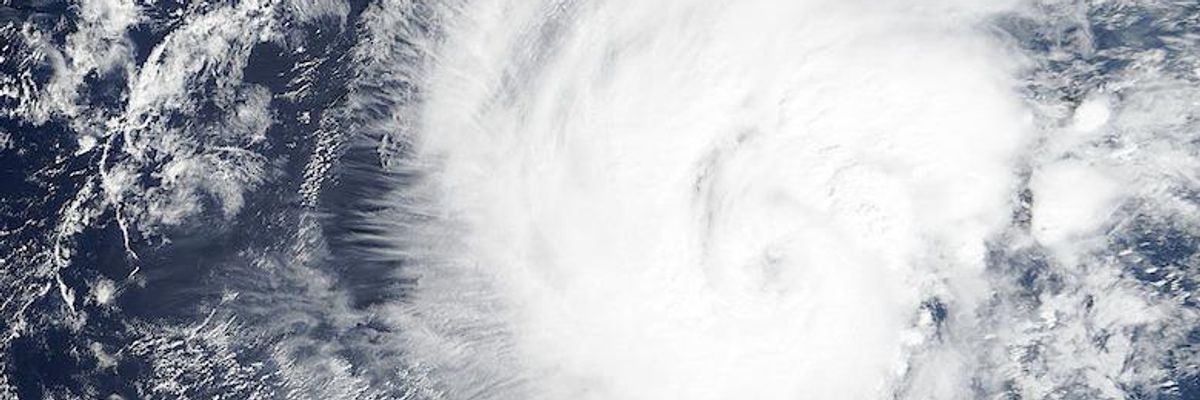

SUBSCRIBE TO OUR FREE NEWSLETTER
Daily news & progressive opinion—funded by the people, not the corporations—delivered straight to your inbox.
5
#000000
#FFFFFF
To donate by check, phone, or other method, see our More Ways to Give page.


Daily news & progressive opinion—funded by the people, not the corporations—delivered straight to your inbox.

Tropical Storm Pali as it was approaching hurricane strength at 2230Z (5:30 pm EST) on Monday, January 11, 2016. (Image credit: NASA)
The world's warm ocean waters are experiencing some very unusual hurricane behavior right now, meteorologists say.
Right now in the eastern Atlantic, Hurricane Alex is headed towards the Azores, and it's the first hurricane to form in month of January since 1938. With sustained winds of over 85 mph, the Category 1 hurricane is even stronger than the hurricane of '38.
The National Hurricane Center posted in an update Thursday morning: "Remarkably, Alex has undergone the transformation into a hurricane."
In the Central Pacific, Tropical Storm Pali on Tuesday became Hurricane Pali. Meteorologist Bob Henson writes: "Pali is the earliest named storm and earliest hurricane on record between the International Date Line and the Americas." That means it beat the record previously held by Hurricane Ekeka in January 1992.
By Thursday morning, Pali was downgraded to a tropical depression.
Weather Underground reports: "This is on the heels of a historically active 2015 tropical season in the Pacific Ocean," adding, "Pali will continue to track fairly close to the equator, potentially ending up between 1 to 2 degrees north latitude. According to the Central Pacific Hurricane Center, this is 'something rarely seen in the central Pacific.'"
Meteorologist Jeff Masters wrote Wednesday that having the two named storms in January in the Atlantic and Central Pacific "would have been unimaginable a few decades ago."
Explaining why they represent anomalies, Masters writes: "The average date of the first named storm in the Atlantic is July 9; the Central Pacific also typically sees its first named storm in July."
Common Dreams is powered by optimists who believe in the power of informed and engaged citizens to ignite and enact change to make the world a better place. We're hundreds of thousands strong, but every single supporter makes the difference. Your contribution supports this bold media model—free, independent, and dedicated to reporting the facts every day. Stand with us in the fight for economic equality, social justice, human rights, and a more sustainable future. As a people-powered nonprofit news outlet, we cover the issues the corporate media never will. |
The world's warm ocean waters are experiencing some very unusual hurricane behavior right now, meteorologists say.
Right now in the eastern Atlantic, Hurricane Alex is headed towards the Azores, and it's the first hurricane to form in month of January since 1938. With sustained winds of over 85 mph, the Category 1 hurricane is even stronger than the hurricane of '38.
The National Hurricane Center posted in an update Thursday morning: "Remarkably, Alex has undergone the transformation into a hurricane."
In the Central Pacific, Tropical Storm Pali on Tuesday became Hurricane Pali. Meteorologist Bob Henson writes: "Pali is the earliest named storm and earliest hurricane on record between the International Date Line and the Americas." That means it beat the record previously held by Hurricane Ekeka in January 1992.
By Thursday morning, Pali was downgraded to a tropical depression.
Weather Underground reports: "This is on the heels of a historically active 2015 tropical season in the Pacific Ocean," adding, "Pali will continue to track fairly close to the equator, potentially ending up between 1 to 2 degrees north latitude. According to the Central Pacific Hurricane Center, this is 'something rarely seen in the central Pacific.'"
Meteorologist Jeff Masters wrote Wednesday that having the two named storms in January in the Atlantic and Central Pacific "would have been unimaginable a few decades ago."
Explaining why they represent anomalies, Masters writes: "The average date of the first named storm in the Atlantic is July 9; the Central Pacific also typically sees its first named storm in July."
The world's warm ocean waters are experiencing some very unusual hurricane behavior right now, meteorologists say.
Right now in the eastern Atlantic, Hurricane Alex is headed towards the Azores, and it's the first hurricane to form in month of January since 1938. With sustained winds of over 85 mph, the Category 1 hurricane is even stronger than the hurricane of '38.
The National Hurricane Center posted in an update Thursday morning: "Remarkably, Alex has undergone the transformation into a hurricane."
In the Central Pacific, Tropical Storm Pali on Tuesday became Hurricane Pali. Meteorologist Bob Henson writes: "Pali is the earliest named storm and earliest hurricane on record between the International Date Line and the Americas." That means it beat the record previously held by Hurricane Ekeka in January 1992.
By Thursday morning, Pali was downgraded to a tropical depression.
Weather Underground reports: "This is on the heels of a historically active 2015 tropical season in the Pacific Ocean," adding, "Pali will continue to track fairly close to the equator, potentially ending up between 1 to 2 degrees north latitude. According to the Central Pacific Hurricane Center, this is 'something rarely seen in the central Pacific.'"
Meteorologist Jeff Masters wrote Wednesday that having the two named storms in January in the Atlantic and Central Pacific "would have been unimaginable a few decades ago."
Explaining why they represent anomalies, Masters writes: "The average date of the first named storm in the Atlantic is July 9; the Central Pacific also typically sees its first named storm in July."